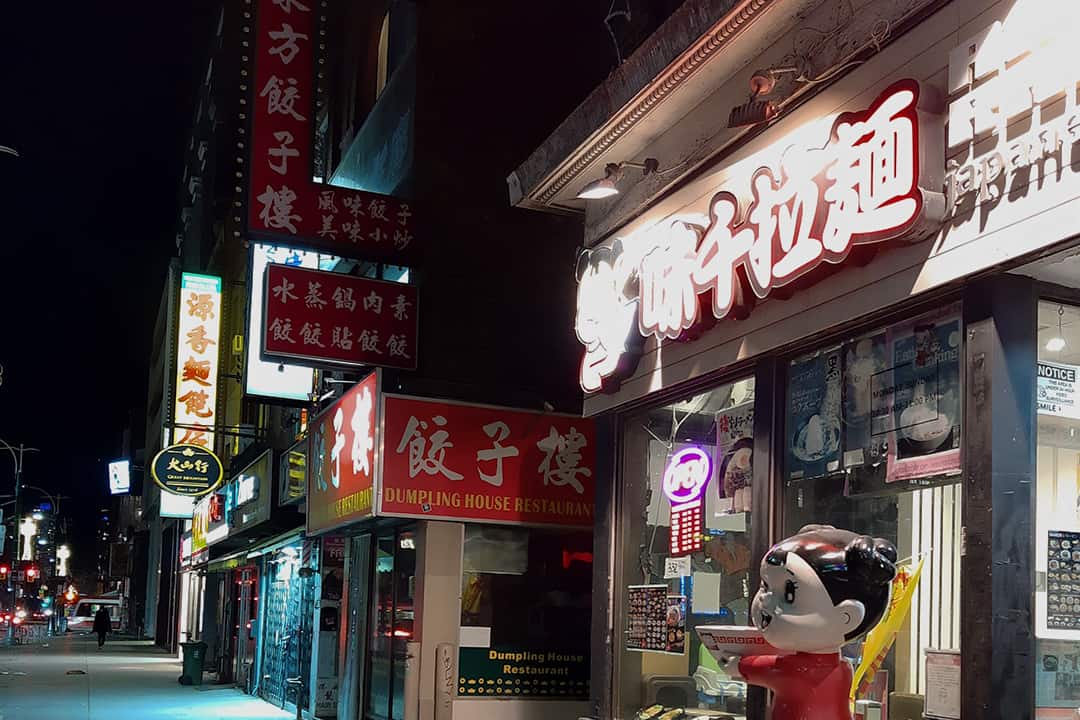Since 2019, members of the downtown Chinatown community have worried that a proposed mid-rise redevelopment at 315–325 Spadina Avenue will accelerate gentrification and displace vulnerable residents from the neighbourhood.
On February 17, grassroots advocacy group Friends of Chinatown Toronto held a town hall to explore a long-term solution to these concerns — one rooted in democratic control and community care.
At the town hall, which drew around 160 attendees, U of T graduate students Chiyi Tam and Zeina Ahmed presented findings from their own research into the possibility of creating a community land trust (CLT) in Chinatown, through which the community could own a portion of the land.
Toronto’s Chinatown is uniquely vulnerable
In December 2020, Tam and Ahmed, alongside researchers Thomas Kempster, Sanjida Rabbi, and Nick Vo, published a research report titled “Community Power for Anti-Displacement: An Inclusive Future for Downtown Chinatown.” Their research, which was completed as part of a U of T graduate course, found that Toronto’s downtown Chinatown is insufficiently protected from the intense development pressure the area will face in the coming years.
Ahmed explained that Chinatown’s history of displacement renders it more vulnerable than similar neighbourhoods throughout North America. Toronto’s Chinatown initially existed between Queen Street and Dundas Street but was uprooted to Spadina Avenue by redevelopment.
Accordingly, Chinatown lacks the fetishized pseudo-Chinese architecture that other Chinatowns use to self-exoticize the neighbourhood for tourism. Tam noted that displacement precludes historic building protection, which could have helped preserve the neighbourhood through policy.
The research group also found that Toronto is one of the only cities in the world that has a Chinatown but lacks a Chinatown-specific planning policy. The report highlighted, for example, that Vancouver’s Chinatown enjoys a “historic district” designation, as well as an area plan, an economic plan, and design guidelines that help conserve heritage.
Tam emphasized that, in comparison to other cities, Toronto’s planning system lacks the tools necessary to protect neighbourhoods like Chinatown — for example, commercial rent control and tenant right-to-purchase legislation.
Redevelopment at 315–325 Spadina Avenue could be a “turning point”
So far, Toronto’s downtown Chinatown has enjoyed informal protection in the form of fractured property ownership, which has kept the neighbourhood untouched by major developments in the last 10–15 years. To create a lot large enough for a profitable development, potential developers must buy and merge the neighbourhood’s small land parcels into a larger piece of real estate, a process that could take a long time. In the case of 315–325 Spadina Avenue, the developer already owns some of the land.
However, Ahmed told The Varsity that across Toronto, once a new building diverges from the established structures in a neighbourhood, “It’s like a domino effect.” New developments that follow tend to be “around the same scale and the same height.”
As the research group conducted interviews with Chinatown community members, the 315–325 Spadina development repeatedly emerged as a potential turning point of the same kind: perhaps a new mid-rise could open the neighbourhood up to more development.
When considering a changing Chinatown, interviewees from the community worried about the disappearance of Chinatown’s culturally competent businesses and affordable food. They also conveyed unease about the loss of Chinatown’s rooming houses, which provide affordable housing to community members, including older adults.
The displacement of Chinatown’s older adults would be widely felt. Many research interviewees expressed an attachment to the “elderly Chinese women selling their homemade dumplings and backyard-grown vegetables on the corner of Spadina and Dundas,” Tam said.
These “veggie grannies,” as she called them, are “emotional cornerstones for a lot of us,” and their presence, or a lack thereof, might serve as a litmus test for whom Chinatown is for.
How can a community land trust help?
Ahmed noted that even if interviewees were uncertain of what community protection might look like, they expressed a need for a strategy to keep valued assets within the community.
A CLT is a non-profit model that “takes land off the property market for long-term use, typically by lower income communities,” Ahmed explained. To create a CLT, community residents pool resources together to buy property for the benefit of the whole community.
Anything on that land — including housing, stores, and parks — is then governed by the CLT. As a result, the CLT can ensure land is used according to community interests. In the case of Toronto’s Chinatown, that might look like preserving affordable housing.
The strategy was not discussed specifically for the 315–325 Spadina Avenue development, but could serve as the blueprint for a larger project of protecting the area.
According to Tam, a CLT gives a neighbourhood more power than a heritage designation, which “does a very good job of freezing building facades in time” without protecting workers and tenants from the effects of gentrification.
In fact, Chinatowns across North America, including ones in Boston and New York City, have used CLTs as a strategy to resist displacement. The CLT in Boston’s Chinatown has become so reputable that property owners looking to sell land in the area now invite the CLT to put an offer in.
Establishing a CLT in Toronto’s Chinatown would take work: data collection, fundraising, property acquisition, and community organization. Still, as Tam told The Varsity, similar organizational structures already exist in Chinatown, although they aren’t grounded in neighbourhood advocacy. For example, Chinese family associations already collectively own land in the area. She also noted that U of T owns housing in Chinatown. “Hypothetically, that’s a community benefit, but they’re charging a lot for those dorms,” she said.
A downtown Chinatown CLT could then fill a gap for nonprofit property ownership that’s “grounded in community power and benefit.”


